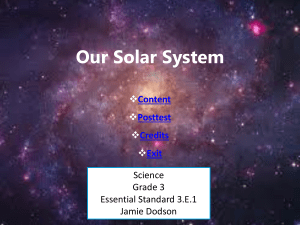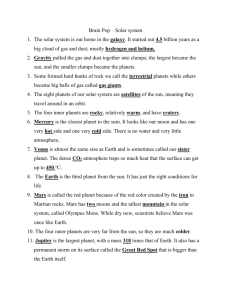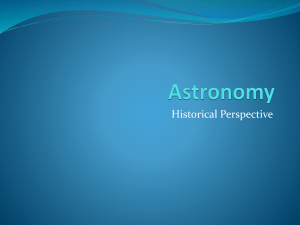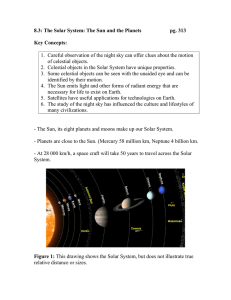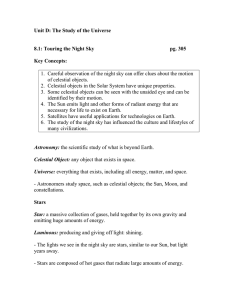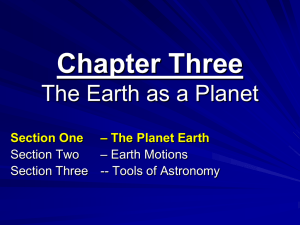Semester 2 Quiz Show
advertisement
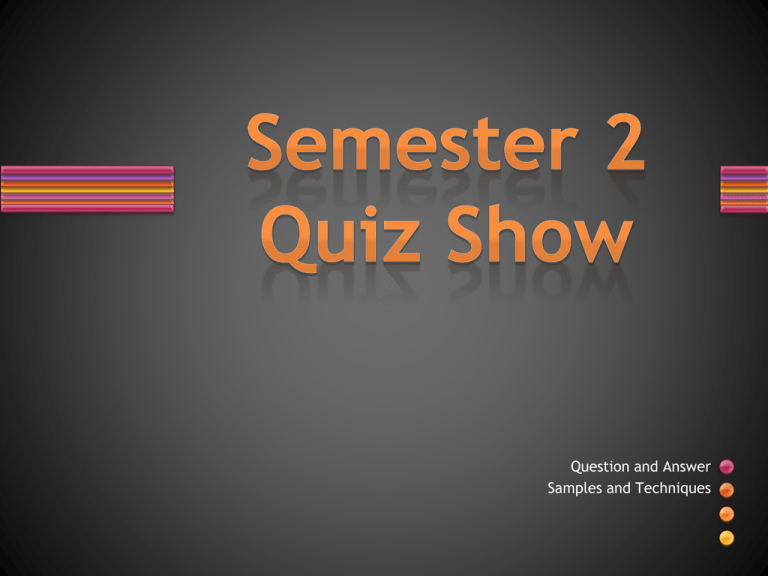
Question and Answer Samples and Techniques What is a pure substance that cannot be broken down into simpler substances? A substance made of 2 or more elements is a compound. Element, compound or mixture? water Would XY represent an element, compound or mixture? Each capital letter represents an element. Since XY are touching it represents they are chemically combined. A element is a non-pure substance. Would Xy represent an element, compound or mixture? Each capital letter represents an element. Since X is the ONLY capital letter, it represents an element. Element, compound, or mixture? Oxygen Compounds can be broken down into elements. Which element makes up most of Earth’s atmosphere? It makes up 78% of the atmosphere Which elements and their percentages make up the Earth’s atmosphere? Nitrogen 78% Oxygen 21% Other 1% What elements make up the Earth’s crust? Iron 35% Oxygen 30% Silicon 15% Magnesium 13% Nickel 3% Other 4% What is a substance that has two or more different elements chemically bonded together? How many different elements are in C6H12O6 + 6O2 6CO2 + 6H2O 26- 6 carbon, 12 hydrogen, 18 oxygen atoms 4- sugar, oxygen, carbon dioxide, and water 3- carbon, oxygen, and hydrogen 52- add all the numbers together 19- count only the coefficients Which substances are examples of compounds? 1 CO2 3 S 2 Co 4 KCl What are the icy masses that have an elliptical orbit around the Sun? Made of water, carbon dioxide, ammonia, dirt and rocks, carbon based matter. Which celestial body is the center of our solar system, around which every planet orbits? The Galilean moons include Callisto, Europa, lo, and Ganymede. What characteristics best describe the inner planets? Inner planets are the planets between the sun and the asteroid belt. Gas giants are the outer planets of our solar system. The Sun is a __. Star Planet Gas Giant Comet Asteriod What celestial object orbits the Earth? The Sun is a star. Smaller celestial objects that orbit planets are _____________? What movement is shown in the picture? What do we call the four natural satellites around Jupiter? Match the term with the descriptor 1. Inner planets a. Space rock hits Earth 2. Outer planets b. Have a tail 3. Comets c. Rocky 4. Asteroids d. Gas giants Meteorite e. Float in belt A _________ is a celestial object with a small mass and an elliptical orbit. Which are objects in our solar system? asteroids Sun Moons planets All the above What is the purpose of the International Space Station? To provide a place for scientists to do experiments To provide a cooling place for the aircraft To provide, collect and develop films To provide a place for scientist to do lunges To provide a place for scientists to make satellites Match the planet to the characteristic Uranus Closest to the sun Saturn Rotates clockwise Venus Spins on its side Mars Ring of rocks and debris Mercury Two moons Match the items on the left to the items on the right. Sodium CO2 Hydrogen Co Cobalt Na Water H Carbon dioxide H2O What is the formula for DENSITY? Remember that the TOP dog goes inside the box (dog house) Ruff ruff!! A natural satellite is a body in space that revolves around a more massive body. The equipment astronomers use to study our solar system. An equipment that has actually flown through, taken pictures, and studied most of our solar system What is gravity? What affects the strength of the gravitational pull on an object? Gravity and motion control the orbit of a planet. Convection is the transfer of heat in a fluid (liquid or gas) by the movement of heated particles (currents). Transfer of heat by direct contact. Heat flows from the warmer object to the colder object. Metals are good conductors. Solids are better conductors of heat than liquids or gases. Transfer of heat energy by electromagnetic waves (rays) is __________________. This is how the sun’s energy gets to earth. When you stand near a fire and warm yourself, most of the warmth you feel has been transferred by radiation. What are indicators of a chemical change? Example: Rust, baking, or burning Types of physical changes are shape, color or size. Which are characteristics of Metals? Shiny Malleable and ductile Are good at conducting electricity Most are solid at room temperature All of the choices Thermal energy always moves from an object of lower temperature to an object of higher temperature. Poor conductors of heat/electricity, brittle and dull (not shiny) of characteristics of __________. Remember: nonmetals are on the right side of the periodic table Metalloids have both characteristics of both metals and nonmetals. A chemical change is a change in the chemical bonds of an object that results in a new substance. The Sun is the original source of energy. C O N V E R S I O N Mechanical Mechanical Heat energy can change to the motion of a train or rocket, cause the mercury in a thermostat to rise or fall, and push the steam through the small opening of a kettle to make it whistle. Mechanical Sound Radiant Electrical Chemical energy can be transformed to make a candle burn and a battery power your MP3 player. The chemical energy in our food allows us to move from class to class and the chemical energy in fuel lets the rocket take off. Mechanical Mechanical C O N V E R S I O N Heat Light A hair dryer or a toaster can transform electrical energy into heat energy. The friction from the wires or the air allows electrical energy to be changed into light energy in a lightbulb or lightning. Finally, a telephone takes in electricity and changes it into sound energy. Light Heat Sound



